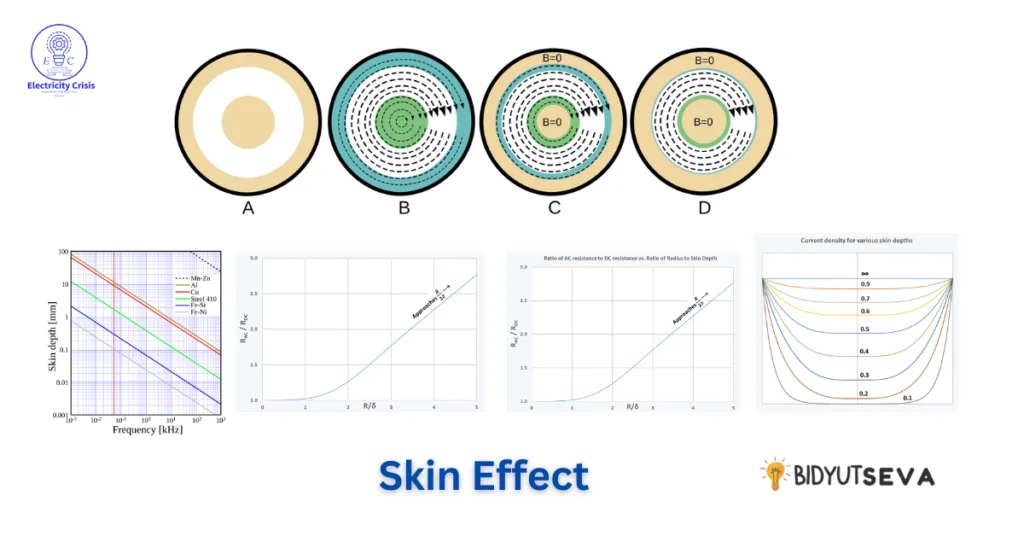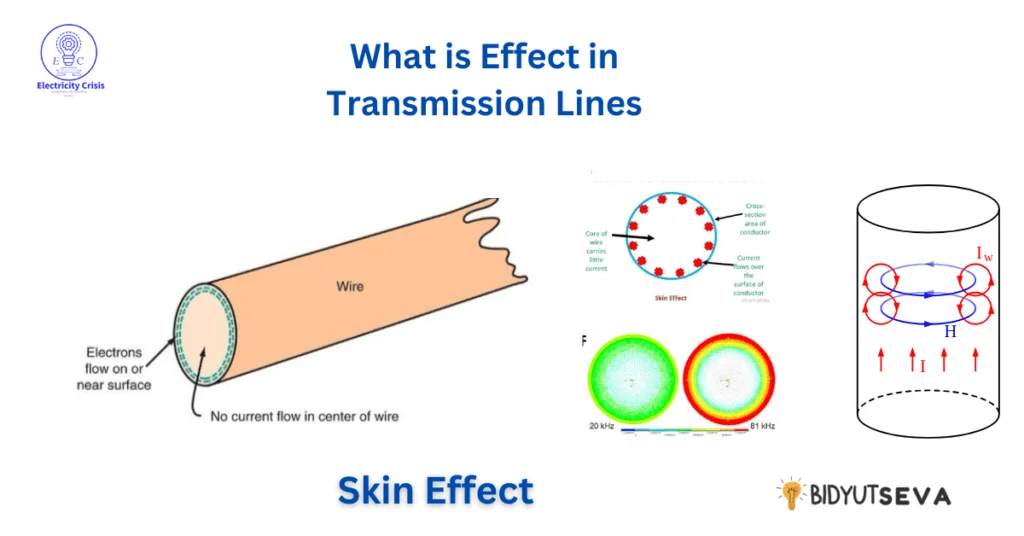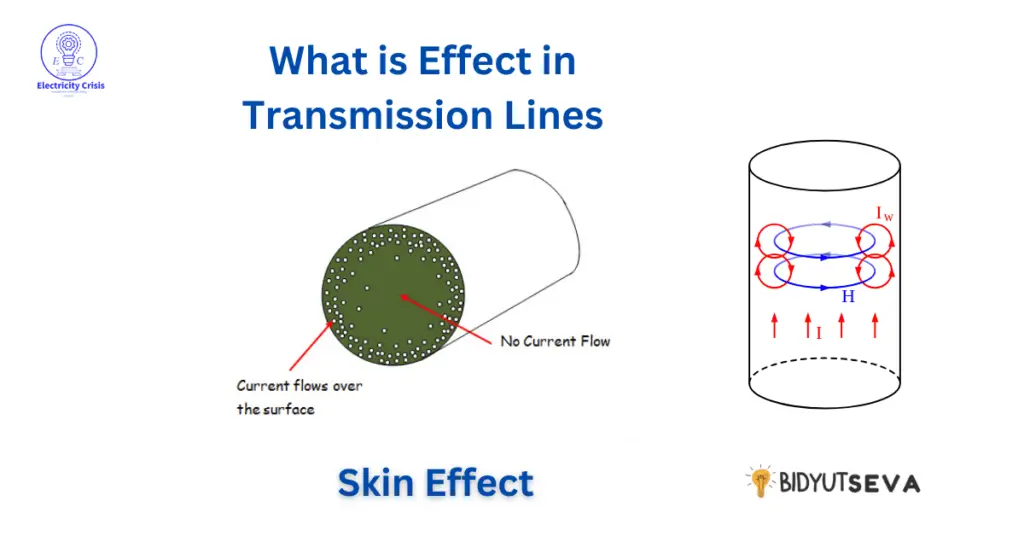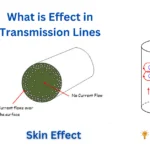Skin Effect in Power Lines is very important in power transmission and transportation lines. However, it is only applicable to AC transmission lines. When AC current flows through a conductor, it flows over the surface of the conductor instead of through it, which is basically the skin effect. The skin effect increases the conductor’s overall resistance and power loss.
The skin effect is very low at the 50 Hz cycle frequency but prominent at radio frequency (RF). However, it does not occur in DC power system.
Table of Contents
The skin effect in power lines increases resistance, reduces efficiency, and causes energy loss, especially in high-frequency AC transmission. This effect forces current to flow near the conductor’s surface, limiting conductivity. Discover the top 4 causes of the skin effect, its negative impact on power transmission, and the best solutions to minimize energy loss.

Learn how Litz wires, hollow conductors, and advanced materials can improve efficiency. In 2025, optimizing power transmission is crucial for reducing costs and enhancing electrical performance. Whether you’re an engineer, researcher, or student, this guide covers everything about the skin effect, including practical ways to counter it.
Stay updated with the latest innovations in electrical engineering to ensure efficient and reliable power distribution. Don’t let the skin effect hinder performance—explore the best techniques to overcome it. Read now to unlock expert insights on improving energy efficiency and reducing resistance in modern power grids!
What is the skin effect ?
When DC current flows in a conductor, this current flows evenly throughout the entire conductor length. However, if AC current is passed through the same conductive wire, it is not distributed evenly throughout the wire but tends to concentrate on the conductor’s surface. This phenomenon is called the skin effect.
When AC current passes through a conductor, it tries to flow over or through the surface of the conductor instead of going through it, which is called the skin effect.
Causes of skin effects
When AC electricity flows through a conductor, the center of the conductor is filled with more flux than its surface.
This is because the inductance at the center is higher than at the surface. When the frequency increases, the back EMF generated does not allow the current to flow through the center. As a result, the current continues to flow through the surface of the conductor, which is the cause of the skin effect.
The causes of Skin Effect in Power Lines can be described in four ways, namely:-
- Inductive Reactance: When high-frequency AC current flows, the self-induction is greater at the outer layer of the conductor than at the center, pushing the current outward.
- Eddy Current Formation: The changing magnetic field causes eddy currents to form in the conductor, which react with the main current and confine it to the outer layer.
- Change in current density: As the frequency increases, the current inside the conductor decreases, and a higher density is created on the outside, resulting in an increase in resistance.
- Magnetic field response: Different conductor layers produce different magnetic field responses, which divert the current towards the surface.
Relationship between frequency and skin effect
- The Skin Effect in Power Lines has less impact at low frequencies (50-60Hz), so it does not cause much of a problem in normal electrical lines.
At high frequencies (RF and MHz-GHz range), the skin effect becomes very high, reducing the conductor’s effective utilization.
- The overall resistance of the line increases due to the skin effect. As a result, when current flows in the line, the line loss increases.
Impact of skin effect on transmission lines
The skin effect causes high-frequency AC current to flow more through the outer layers of the conductor than through the center, which can cause various problems.
- Power is generated in the line due to the skin effect.
- The influence of skin effect on lines increases at higher frequencies.
- As the diameter of the line conductor increases, the skin effect also increases.
- This effect depends on the size of the transmission line conductors. For example, it is increased when solid conductors are used.
- The skin effect causes more current to flow through the outer layer of the conductor, which generates heat and can sometimes damage the wire’s sheath or insulation.
- The conductor used in transmission lines depends on the properties of the material. For example, aluminum conductors have less skin effect than copper conductors.
Skin effect in transmission lines causes power loss, voltage drop, and heat, which reduces the efficiency of the power transmission system. It is particularly problematic for high-frequency and long-distance AC power transmission. However, appropriate conductors and intermediate technologies can reduce the negative effects of skin toxicity.
Factors to consider for skin effects
The extent of the skin effect and its impact depend on several important factors. Out of these, 06 factors are considered as the main ones. These are:
1. Size of the conductor
2. Diameter of the conductor
3. Conductivity of the conductor
4. Frequency
5. Permeability of the conductor and
6. Temperature etc.
The main factors to consider for skin effects are discussed below:-
- This effect depends on the quality of the conductor material used.
- It depends on the conductor diameter, i.e., the skin effect also increases as the diameter increases.
- The higher the frequency, the greater the skin effect.
- Thick and flat conductors have a higher skin effect than round conductors, and hollow or multi-stranded conductors have a lower skin effect.
- DC current does not have a skin effect because it is a constant current.
- The skin effect is greater when using ferromagnetic materials (e.g., iron, nickel) and less when using non-magnetic materials (e.g., copper, aluminum).
- If the load is balanced, the impact of the skin effect may be less. And if the load is uneven, the skin effect may cause more problems.

Ways to reduce skin effects
Various technologies and techniques are used to reduce the skin effect, depending on the conductor’s design, material, and frequency. Below are some effective ways to reduce skin effects:
- Litz wire consists of multiple thin insulated wires, which reduces the skin effect.
- It is effective at high frequencies and is widely used in electronic and radio frequency (RF) applications.
- In multi-stranded cables, current flows through each wire separately, which reduces the skin effect.
- Using hollow conductors avoids unnecessary resistance in the center section, thereby increasing the effective electrical conductivity.
- Copper and silver effectively reduce skin effects because they have high conductivity.
- Silver-coated copper is used in its high-frequency applications.
- DC current does not have the skin effect because it is not variable.
- High-voltage DC (HVDC) transmission, which is used in long-distance power transmission, helps avoid skin effects.
- Using low-frequency AC reduces the skin effect.
- Litz wire or special conductor designs are used if high frequencies are required.
- Flat and ribbon-like conveyors can reduce the skin effect compared to round or tube-shaped conveyors.
- In some cases, using flat or ribbon conductors reduces the skin effect.
- The skin effect increases when more ferromagnetic materials (such as iron and nickel) are used.
- Using non-magnetic materials (such as copper and aluminum) reduces the skin effect.
Techniques such as Litz wire, multi-stranded wire, high-conductivity metals, DC transmission, and proper frequency are important to reduce skin effects. These technologies, especially at high frequencies, can reduce power loss and increase power transmission efficiency.
Conclusion
Skin effect is an important electrical phenomenon that confines the current to the outer layer of a conductor instead of the center in the case of high-frequency AC current flow. This increases the effective resistance of the conductor, generates heat, causes power losses, and reduces the efficiency of the transmission line.
The skin effect is obvious in AC power systems, radio frequency (RF), and high-frequency transmission lines. However, using Litz wire, multi-stranded conductors, and high-conductivity metals can reduce the skin effect. It is also possible to reduce the skin effect by following technologies and techniques such as conversion to DC transmission.
By using the right materials and technologies, it is possible to reduce the negative impact of the skin effect and increase the efficiency of power transmission. This, in the long run, reduces energy waste and improves the efficiency of the power system.
Some common questions (FAQ) regarding skin effects
1. What is the Skin Effect in Power Lines ?
- The Skin Effect is an electrical phenomenon in which high-frequency AC current flows more through the outer layers of a conductor than through the center, increasing the effective resistance.
2. Does the skin effect occur in DC current?
- The skin effect does not occur in DC current because it is a steady current with no frequency.
3. Where is the skin effect most common?
- The skin effect is commonly seen in high-frequency AC power transmission, radio frequency (RF), and electronic circuits.
4. How does the skin effect affect power transmission?
- The skin effect increases the conductor’s effective resistance, resulting in power loss, heat generation, and reduced transmission line efficiency.
5. How to reduce skin effects?
The following techniques are used to reduce skin effects—
- Reducing the radius of the conductor.
- Use of Litz Wire.
- Using non-magnetic materials.
- Using aluminum conductors.
- Using multi-stranded or hollow conductors.
- Using metals with high conductivity (such as silver or copper).
- Using high voltage DC (HVDC) transmission technology.
6. Why does the skin effect occur ?
- High-frequency AC current causes the inductance at the center of the conductor to increase, generating back EMF and pushing the current toward the outer layer of the conductor.
7. Is the skin effect more pronounced at 50-60 Hz frequencies?
- No, the impact of the skin effect is very small at low frequencies (50-60Hz), but it is very large at high frequencies (MHz-GHz).
8. Which type of conductor has less skin effect?
- Multi-stranded Litz wire and hollow conductors have less skin effect because the current distribution is more evenly spread.
9. Does the skin effect cause any problems in AC transmission?
- Yes, it increases power loss, generates heat, and reduces power transmission efficiency in long-distance AC transmission.
10. How can the skin effect be reduced in transmission lines?
- The use of high-voltage DC (HVDC) in transmission lines, multi-stranded conductors, hollow conductors, and high-conductivity metals such as silver or copper can reduce the skin effect.
11. What factors does the skin effect depend on?
The magnitude of the skin effect and its impact depend on several important factors. Out of these, 06 factors are considered as the main ones. These are:
- Size of the conductor
- Diameter of the conductor
- Conductivity of the conductor
- Frequency
12. What happens due to skin effect?
- Skin effect increases the overall resistance of the line. As a result, when current flows in the line, the line loss increases.







